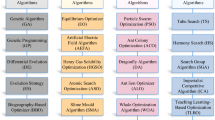Abstract
To decrease the complexity of experimental setup that often results in low reliability of the experimental results for typical offshore floating structures with increasingly excessive mooring lines, a mooring line number simplification methodology is proposed based on equivalent of the vessel/mooring coupled dynamics for vessel with original and simplified mooring systems. The Non-dominated Sorting Genetic Algorithms-II (NSGA-II) is adopted to achieve the static restoring forces equivalent, where the line length, axial stiffness and submerged mass of the simplified mooring system are obtained. The line diameter is then determined based on dynamic restoring forces equivalent when the mooring system is exerted by forced oscillations. Using correlation coefficients, the vessel/mooring coupled dynamics of vessel with original and simplified mooring systems are compared to determine the optimal simplified mooring system. The feasibility of the proposed methodology is demonstrated by an application for a VLFS’s mooring system comprising 20 mooring lines. Two simplified mooring systems are obtained with the correlation coefficients of coupled vessel/mooring dynamics lager than 0.97. It can be concluded that the proposed method can be used as a useful tool to guide mooring line number simplification for model testing.


















Similar content being viewed by others
References
Palo P (2005) Mobile offshore base: Hydrodynamic advancements and remaining challenges. Mar Struct 18(2):133–147
Suzuki H (2005) Overview of megafloat: concept, design criteria, analysis, and design. Mar Struct 18(2):111–132
Watanabe E, Utsunomiya T, Wang CM (2004) Hydroelastic analysis of pontoon-type vlfs: a literature survey. Eng Struct 26(2):245–256
Lamas-Pardo M, Iglesias G, Carral L (2015) A review of very large floating structures (vlfs) for coastal and offshore uses. Ocean Eng 109(15 November 2015):677–690
Felix-Gonzalez I, Mercier RS (2016) Optimized design of statically equivalent mooring systems. Ocean Eng 111:384–397
Fan T, Ren N, Cheng Y, Chen C, Jinping O (2018) Applicability analysis of truncated mooring system based on static and damping equivalence. Ocean Eng 147:458–475
Anouck Renée G, João Borges de S, Karl HJ, William CW (2001) Simulation environment design and implementation: an application to the mobile offshore base. In: Proceedings of the 20th international conference on offshore mechanics and arctic engineering. OMAE, Rio de Janeiro, Brazil, pp 1–9
Girard AR, Empey DM, Webster WC, Hedrick JK (2003) An experimental testbed for mobile offshore base control concepts. J Mar Sci Technol 7(3):109–118
Wang Y, Wang X, Xu S, Ding A (2017) Motion response of a moored semi-submersible-type single module of a vlfs in multi-slope shallow water. Int J Offshore Polar Eng 27(04):397–405
Wang Y, Wang X, Xu S, Wang L (2018) Motion responses of a catenary-taut-hybrid moored single module of a semisubmersible very large floating structure in multisloped seabed. J Offshore Mech Arct Eng 140(3):031102
Wang Y, Xu S, Wang L, Wang X (2018) Motion responses of a catenary–taut–tendon hybrid moored single module of a semisubmersible-type vlfs over uneven seabed. J Mar Sci Technol. https://doi.org/10.1007/s00773-018-0587-6
Hughes SA (1993) Physical models and laboratory techniques in coastal engineering, vol 7. World Scientific, Singapore
Ji C, Yuan Z (2015) Experimental study of a hybrid mooring system. J Mar Sci Technol 20(2):213–225
Kim MH, Koo BJ, Mercier RM, Ward EG (2005) Vessel/mooring/riser coupled dynamic analysis of a turret-moored fpso compared with otrc experiment. Ocean Eng 32(14):1780–1802
Zhang HM, Sun ZL, Yang JM, Gao MZ (2009) Investigation on optimization design of equivalent water depth truncated mooring system. Sci China Ser G Phys Mech Astron 52(2):277–292
Yihua S, Yang J, Xiao L (2009) Hybrid verification of a deepwater cell-truss spar. China Ocean Eng 23(1):1–14
Zhang H, Gao W, Wang Q, Jiang J, Zhao Z (2012) Investigation on optimization design of an equivalent water depth truncated mooring system based on INSGA-II. J Mar Sci Appl 11(2):208–215
Wei H, Xiao L, Tian X, Kou Y (2017) Four-level screening method for multi-variable truncation design of deepwater mooring system. Mar Struct 51:40–64
Deb K, Pratap A, Agarwal S, Meyarivan TAMT (2002) A fast and elitist multiobjective genetic algorithm: NSGA-II. IEEE Trans Evol Comput 6(2):182–197
Low YM, Langley RS (2006) Time and frequency domain coupled analysis of deepwater floating production systems. Appl Ocean Res 28(6):371–385
Xiong L, Yang J, Zhao W (2016) Dynamics of a taut mooring line accounting for the embedded anchor chains. Ocean Eng 121:403–413
Bai X, Huang W, Vaz MA, Yang C, Duan M (2015) Riser-soil interaction model effects on the dynamic behavior of a steel catenary riser. Mar Struct 41:53–76
Chen H, Sipeng X, Guo H (2011) Nonlinear analysis of flexible and steel catenary risers with internal flow and seabed interaction effects. J Mar Sci Appl 10(2):156–162
Zitzler E, Thiele L (1999) Multiobjective evolutionary algorithms: a comparative case study and the strength pareto approach. IEEE Trans Evol Comput 3(4):257–271
Eckart Z, Marco L, Lothar T (2001) SPEA-II: improving the strength pareto evolutionary algorithm. TIK-report, 103
Corne DW, Knowles JD, Oates MJ (2000) The pareto envelope-based selection algorithm for multiobjective optimization. In: International conference on parallel problem solving from nature. Springer, New York, pp 839–848
Corne DW, Jerram NR, Knowles JD, Oates MJ (2001) PESA-II: region-based selection in evolutionary multiobjective optimization. In: Proceedings of the 3rd annual conference on genetic and evolutionary computation. Morgan Kaufmann Publishers Inc., Burlington, pp 283–290
Acknowledgements
The authors greatly acknowledge the supports of the National Natural Science Foundation of China (Grant 51709170), the Ministry of Industry and Information Technology (Mooring position technology: floating support platform engineering(II)) and the Shanghai Sailing Program (Grant 17YF1409700).
Author information
Authors and Affiliations
Corresponding author
Additional information
Publisher's Note
Springer Nature remains neutral with regard to jurisdictional claims in published maps and institutional affiliations.
About this article
Cite this article
Liang, M., Xu, S., Wang, X. et al. Simplification of mooring line number for model testing based on equivalent of vessel/mooring coupled dynamics. J Mar Sci Technol 25, 573–588 (2020). https://doi.org/10.1007/s00773-019-00664-x
Received:
Accepted:
Published:
Issue Date:
DOI: https://doi.org/10.1007/s00773-019-00664-x



